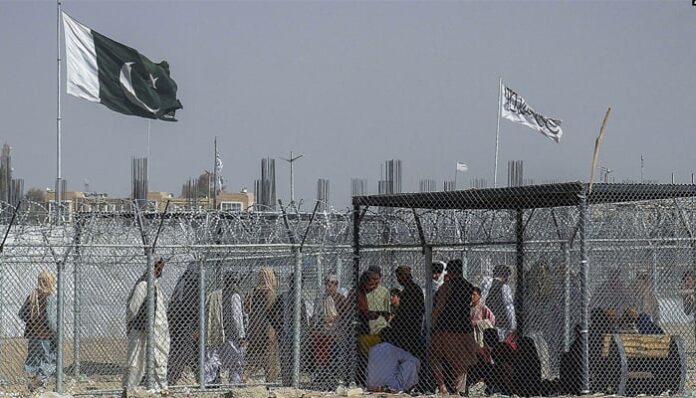Pakistan has complex geopolitical dynamics on its western borders, with historical context, contemporary challenges, and potential solutions for ensuring stability in the region. Afghanistan and Iran bordering Pakistan’s Western side, have unique histories, cultures, and strategic importance.
The historical context of British colonial rule is essential to understand the complexities of Pakistan’s western borders. The Durand Line, drawn in the late 19th century, arbitrarily divided Pashtun tribal lands between what is now Pakistan and Afghanistan, creating a source of long-standing resentment and disputes. Afghanistan has been a key factor in the region’s instability, with ongoing political turmoil, the Soviet invasion in the 1980s, and the subsequent civil war and Taliban rule contributing to a volatile situation along the Pakistan-Afghanistan border.
Pakistan’s western border with Iran has been relatively stable, with a history of cooperation in some areas. However, Iran’s relations with Pakistan are influenced by issues such as border security, the Balochistan insurgency, and sectarian conflicts. Contemporary challenges in the region include militancy and terrorism, refugees and internally displaced persons (IDPs), economic underdevelopment, cross-border trade, and water disputes. Diplomatic efforts should be intensified to address border disputes, while counterterrorism and counterinsurgency efforts should focus on targeting extremist groups operating on Pakistan’s soil and cooperating with Afghanistan to dismantle their safe havens.
Pakistan and Iran have am intricate and multifaceted relationship shaped by their shared interests and challenges. The countries share a 959-km border, which has strategic and economic implications. They have deep cultural, historical, and religious ties, with the majority of Iranians being Shia Muslims and the majority of Pakistanis being Sunni Muslims. Economic cooperation between the two countries has been a priority, particularly in trade, energy, and infrastructure. The Iran-Pakistan gas pipeline, also known as the Peace Pipeline, aims to transport Iranian natural gas to Pakistan, but has faced delays and challenges, including international sanctions on Iran. Regional security and stability are now more crucial due to the changing world, and Pakistan and Iran must manage these shared security problems through increased coordination and intelligence sharing.
The triangular interactions between Iran, Pakistan, and Saudi Arabia create a composite geopolitical situation, with Pakistan in a difficult balancing act to maintain close ties without upsetting Iran. Military cooperation between Pakistan and Iran has been influenced by regional security dynamics and shared objectives. Border security, counterterrorism initiatives, joint training exercises, defence industry cooperation, and maritime security have been key areas of cooperation.
Both countries understand that their security and stability are linked, growth in Pakistan opens the door for a wealthy Afghanistan, while a stable Afghanistan guarantees Pakistan’s western boundary. Improved relations between the two nations are essential to the development and security of the area. Balancing India’s involvement in Afghanistan and its longstanding rivalry with Pakistan has implications for the region’s stability, making stability beyond kinetics a multifaceted challenge.
Balochistan’s strategic position and geopolitical dynamics have historically impacted relations between Pakistan and Iran. Energy cooperation is also a significant aspect of their relations, with Pakistan importing electricity from Iran to meet its energy needs during power shortages. Border security issues, such as smuggling and illegal immigration, have been addressed through increased cooperation and coordination. Diplomatic relations between the two countries maintain embassies in each other’s capitals and engage in dialogues on regional and international issues, including those related to Afghanistan and the Middle East.
The situation in Afghanistan has been a critical concern for both countries, with Pakistan and Iran working together on issues like the Afghan peace process and managing the refugee crisis. Geopolitical factors, such as the United States, Saudi Arabia, and the Gulf states, have influenced their relations, particularly in relation to their relationships with the USA and regional rivalries. Despite challenges such as border incidents, drug trafficking, and sectarian issues, both countries have sought to maintain their relations and cooperation.
The Pak-Afghan border has become a contentious issue due to the Afghan state’s rejection of the border, rising militancy in Pakistan, and cross-border assaults. The unrestricted movement across the border poses a threat to internal security for successive regimes in Pakistan and Afghanistan. Over 90 percent of the flow from Afghanistan into Pakistan is unmonitored daily, forcing Pakistan to consider stricter border management measures, such as fences. To achieve long-term peace and stability for Afghanistan and Pakistan, an efficient border management system is required. The Pakistan Army has initiated a strategy for efficient border management, including building border forts, installing monitoring technology, building crossing terminals, and erecting a border fence without cooperation from Afghanistan.
Effective border control aims to limit the cross-border movement of terrorists and their facilitators and abettors and replace the centuries-old paradigm of unregulated borders with one monitored and regulated in accordance with tribal regions’ social norms. The fence covers hundreds of kilometres of high infiltration-prone tribal districts including Khyber, Bajaur, Mohmand, North and South Waziristan, Kurram, and Dir/Chitral. The entire western border is monitored by the Special Intrusion Detection System (SID), which faces challenges such as mountain ranges, severe weather, cross-border shooting on fence companies, and mountain patrols.
Economic development in the border regions is crucial for stability, with investment in infrastructure, education, and healthcare improving living conditions and reducing the allure of militancy. Humanitarian support from the international community should continue to provide humanitarian assistance to Afghan refugees in Pakistan and support IDPs. Formalizing cross-border trade agreements with Afghanistan and Iran can help regulate commerce and reduce smuggling, contributing to economic growth in the border regions and fostering cooperation.
Both countries understand that their security and stability are linked, growth in Pakistan opens the door for a wealthy Afghanistan, while a stable Afghanistan guarantees Pakistan’s western boundary. Improved relations between the two nations are essential to the development and security of the area. Balancing India’s involvement in Afghanistan and its longstanding rivalry with Pakistan has implications for the region’s stability, making stability beyond kinetics a multifaceted challenge.























